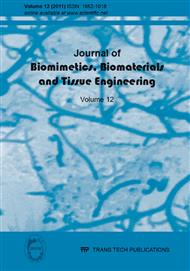p.1
p.25
p.41
p.51
p.59
p.83
p.91
Synthesis and Characterization of Sol-Gel Derived Hydroxyapatite-Bioglass Composite Nanopowders for Biomedical Applications
Abstract:
The main purpose of this study is to prepare and characterize hydroxyapatite (HA)–10%wt bioglass (BG) composite nanopowders and its bioactivity. Composites of hydroxyapatite with synthesized bioglass are prepared at various temperatures. Suitable calcination temperature is chosen by evaluating of the phase composition. X-ray diffraction (XRD), Transmission electron microscopy (TEM) and Scanning electron microscopy (SEM) techniques are utilized to characterize the prepared nanopowders. The bioactivity of the prepared composite samples is evaluated in an in vitro study by immersion of samples in simulated body fluid (SBF) for predicted time. Fourier transformed infrared (FTIR) spectroscopy and inductively coupled plasma (ICP) are used for evaluation of apatite formation and the bioactivity properties. Results show that HA-BG composite nanopowders are successfully prepared without any decomposition of hydroxyapatite. The suitable temperature for calcination is 600°C and the particle size of hydroxyapatite is about 40-70 nm. The apatite phase forms after 14 days immersing of the samples in SBF. It could be concluded that this process can be used to synthesize HA-BG composite nanopowders with improved bioactivity which is much needed for hard tissue repair and biomedical applications.
Info:
Periodical:
Pages:
51-57
Citation:
Online since:
February 2012
Authors:
Price:
Сopyright:
© 2011 Trans Tech Publications Ltd. All Rights Reserved
Share:
Citation:


